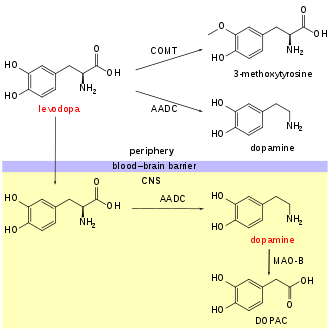
An aromatic L-amino acid decarboxylase inhibitor (synonyms: DOPA decarboxylase inhibitor, extracerebral decarboxylase inhibitor, DDCI and AAADI) is a medication of type enzyme inhibitor which inhibits the synthesis of dopamine by the enzyme aromatic L-amino acid decarboxylase (AADC, AAAD, or DOPA decarboxylase). It is used to inhibit the decarboxylation of L-DOPA to dopamine outside the brain, i.e. in the blood. This is primarily co-administered with L-DOPA to combat Parkinson's disease. Administration can prevent common side-effects, such as nausea and vomiting, as a result of interaction with D2 receptors in the vomiting center (or cheomoreceptor trigger zone) located outside the blood–brain barrier.
Examples of extracerebral decarboxylase inhibitors include carbidopa and benserazide.
Indications
Peripherally selective DDCIs incapable of crossing the protective blood–brain barrier (BBB) are used in augmentation of L-DOPA (levodopa) in the treatment of Parkinson's disease (PD) to block the conversion of L-DOPA into dopamine outside the brain, for the purpose of reducing adverse side effects. Combined L-DOPA and DDCI therapy does not inherently decrease peripheral cardiovascular side effects of L-DOPA administration; however, combined therapy potentiates the central effects of L-DOPA by decreasing the dose-dependency 4-5 fold, therein allowing for effective Parkinson's disease treatment without cardiovascular risk associated with high peripheral dopamine.
List of DDCIs
- Benserazide (Madopar, Prolopa, Modopar, Madopark, Neodopasol, EC-Doparyl, etc.)
- Carbidopa (Lodosyn, Sinemet, Pharmacopa, Atamet, Stalevo, etc.)
- Methyldopa (Aldomet, Aldoril, Dopamet, Dopegyt, etc.)
- alpha-Difluoromethyl-DOPA (DFMD)
- 3',4',5,7-Tetrahydroxy-8-methoxyisoflavone
- Epigallocatechin gallate (EGCG)
- Epigallocatechin (EGC)
References
- Mutschler, Ernst; Schäfer-Korting, Monika (2001). Arzneimittelwirkungen (in German) (8 ed.). Stuttgart: Wissenschaftliche Verlagsgesellschaft. pp. 313–316. ISBN 3-8047-1763-2.
- Calne, D. B.; Reid, J. L.; Vakil, S. D.; Rao, S.; Petrie, A.; Pallis, C. A.; Gawler, J.; Thomas, P. K.; Hilson, A. (1971). "Idiopathic Parkinsonism treated with an extracerebral decarboxylase inhibitor in combination with levodopa". British Medical Journal. 3 (5777): 729–732. doi:10.1136/bmj.3.5777.729. PMC 1798919. PMID 4938431.
- "Editorial: Dopa decarboxylase inhibitors". British Medical Journal. 4 (5939): 250–1. November 1974. doi:10.1136/bmj.4.5939.250. PMC 1612227. PMID 4425849.
- Cotzias, G. C., Papavasiliou, P. S., and Gellene, R., New England Journal of Medicine, 1969, 280, 337.
- Yahr, M. D., in Advances in Neurology, ed. M. D. Yahr, p. vi, vol. 2. New York, Raven Press, 1973.
| Pharmacology: enzyme inhibition | |||||||||||
|---|---|---|---|---|---|---|---|---|---|---|---|
| Class | |||||||||||
| Substrate |
| ||||||||||
| Antiparkinson agents (N04) | |||||||||||
|---|---|---|---|---|---|---|---|---|---|---|---|
| Dopaminergics |
| ||||||||||
| Anticholinergics | |||||||||||
| Others |
| ||||||||||
| |||||||||||
| Dopamine receptor modulators | |||||||
|---|---|---|---|---|---|---|---|
| D1-like |
| ||||||
| D2-like |
| ||||||